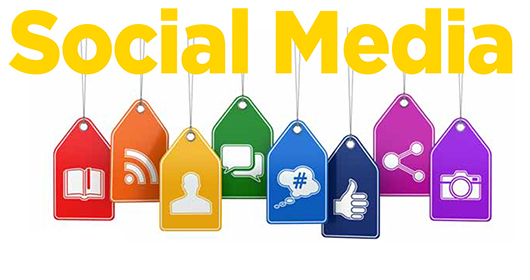Social Media @ Work For HR
By Nancy Painter
When LinkedIn was launched in 2003, few in HR could have predicted the role social media would come to play in the profession. In fact, few probably recognized the term “social media” in 2003.
Today LinkedIn has 500 million members (106 million active) and operates in 24 languages in 200 countries and territories. What’s more, it’s just one of many social media platforms, although it’s often the one most associated with HR because it matches hiring companies and job-seekers.

Angie Poulsen
“Previously social media was a marketing tool,” explains Angie Poulsen, HR manager for First Credit Union and Insurance for the Comox Valley on Vancouver Island. “The real trend now is recognizing how you can use it.”
Selective First Steps Reward
If you’re new to using anything beyond LinkedIn and your personal Facebook account, embracing social media can be daunting, especially because of the explosion of constantly evolving and expanding options.
“It’s important to keep your eye on trends,” Poulsen advises, “or you could spend your time on platforms that are not reaching your target group.”
She recommends that HR social media newcomers subscribe to a few social media industry blogs to bring the trends to them. She cites hootsuite.commashable.com and digitaltrends.com for social media sources, and connecting with disruptHR for more HR-specific viewpoints (connect with the Victoria and Vancouver groups at disrupthr.co/city).
Connect with Your Community
“One of the biggest challenges is the overwhelming number of platforms,” says Maurice Fernandes, manager of employment brand and HR social media at Ceridian. “You have to look at where your target audience is. If they’re active on Twitter, then you need to put effort into Twitter.

Maurice Fernandes
“Look at the types of people engaged in each platform. We’ve also surveyed employees about their social media use; they’re a great source of information. We ask applicants, to find out where our talent is active on social media,” he explains. “You need to connect with the strong pulse of your community as a whole. Look for associated social networks. If they share our interests, it would indicate to me that we need to have an active voice there.”
Go In With a Goal
And while social media raises valid concern among leadership, practitioners cite a long list of benefits to using social media in HR.
Peter Reek is the founder and president of Smart Savvy and Associates which specializes in recruitment for the communications and marketing sectors. Reek uses different platforms to achieve varied goals beyond the obvious one of attracting applicants to available openings: positioning Smart Savvy as a thought-leader in its field, sharing culture, and offering advice.
“People are opting in, choosing to follow us, which generally means they’re interested in what we’re doing. We can let growth happen organically, knowing our audience is fairly focussed on the same topics we are,” Reek says. “It’s also quite nimble if you need to get a message out quickly, and the visual components really help us capture attention in ways we need.”
Poulsen concurs: “It’s a great way to connect with a diverse community. It’s relatively inexpensive with a wide reach.”
Expand Your Concept of Communications
“Traditional media does not allow for two-way communication and engagement,” Fernandes says. “In social media, people can like it, share it and ask questions. Using social media allows us to connect with a diverse talent pool that we couldn’t access in the past. Some people get all their news online. This gives us an opportunity to connect with those audiences in a way that’s very beneficial for us as well.”
“Social media platforms allow some pretty cool dynamic content—short videos, vignettes of employees in fun work activities or volunteer activities. It’s another avenue for people to explore what it’s really like to work here.”

Peter Reek
Ceridian’s identity as primarily a tech company is part of its culture, and that becomes obvious when it posts photos of costumed employees in their “May the 4th (Be with You)” parade.
Another vital benefit is that social media can alert you to issues that are brewing, Poulsen points out. “There are some risks associated with that,” she admits, “but we’re past the point where you can just not engage with people. Transparency is going to happen regardless, so you might as be the one controlling it.”
The key, she maintains, is to address issues that are raised, whether solving them or explaining why it has to be the way it is. “It’s important for the general public to see that you’re trying to respond and be respectful.”
Don’t Talk About Your Culture—Show It
Social media presents “a really great opportunity to create a presence for potential applicants or other groups—organization members, the larger community, anyone,” Poulsen says.
“Your content tone shows your culture and the values of your organization.” The alternative, she adds, is that you have zero presence and when people go online to learn about you, they see your competitors’ social media posts where you have none.
Taking control of your online presence enables you to demonstrate your culture instead of talking about it. “It’s a great tool to demonstrate who you are. There’s competition to hire good folks; they have choices,” explains Poulsen. Some job-seekers choose whether to even approach an employer based on what they’ve learned about the organization online.
Tailor Your Efforts to Effect
In a world of choices, different platforms work better for specific messaging for HR audiences.
“We use LinkedIn to try to share things that are valuable to others in our profession, for those hoping to make strides in their career or to hire with efficacy,” Reek says. “We provide thought-leadership, highlight opportunities and build community.” Blog posts can be published on LinkedIn.
On the other hand, Smart Savvy uses Twitter to point to items of interest to their followers, offering advice and best practices, as well as current job opportunities.
Facebook use goes beyond sharing articles and job opportunities to showcase the company culture through imagery of events, highlights of different team members, key outcomes from their monthly leader lounge and other things happening in the company. They also use Facebook to recognize clients’ outstanding accomplishments.
Instagram offers a further visual distillation, capturing highlights of their company culture and great things that are happening with clients. Many companies include images or videos of employees doing volunteer work, especially if it’s supported by the company, to help demonstrate their culture.
“In a business sense, LinkedIn is geared and marketed toward businesses,” Poulsen says. “But business is also going to other platforms because that is where the people are.”
Strategy, Tactics and Due Diligence
However, there’s more to getting started in social media than knowing which platforms you want to use for what. As with any activity, strategy needs to come before tactics if you want to achieve concrete success.
Once you think you have established what you want to accomplish with social media (and how it links to business objectives), start with the aforementioned research on which channels your target audience uses.
The next step is doing due diligence within your organization.
“You need to have your company’s buy-in,” Poulsen says. “You need to understand its vision and goals, and it needs to understand what yours are for your social media use.”
Transparency is key, she adds. Establish guidelines for the use of social media. Do you want employees to use it too? Then help them understand what they can and can not do on company platforms. How will you monitor your channels? How will you respond if something negative shows up on your feed?
You need to gauge the organization’s level of comfort with using social media, because once you’re using it you need to be able to respond quickly without being defensive, and be consistent in your approach, she says.
Objectives and Assessments
There was some concern about the “social” part of social media when it was first introduced as a business tool at Ceridian, Fernandes says. “We had to be clear about what the intended conversation was on each channel. For us, it’s more about culture. Facebook has 1.2 billion users—that’s pretty hard to ignore.”
They also got pushback on using Instagram, he recallls, until they explained their goals and how the platform would be used to achieve them.
“At first we ran into our social media being ‘Job Board Lite,’ because we only posted open roles,” Fernandes adds. “We quickly realized that if we used that strategy, we were only going to attract those people who were actively look for a job at that time. We had to step back and say, we want to share more about who we are. We need a response strategy to engage our audience.”
Grow Organizational Ambassadors
“You get far better engagement from your audience when actual employees are saying something real about your organization,” Poulsen adds. “It’s more impactful and more transparent—but it should never be forced. Focus on what to do, not on what not to do. It’s mostly common sense.”
“We really encourage our employees to take part,” Fernandes says. ““Employees are probably the most trusted source of information on a company. They’re powerful brand advocates and their involvement should be embraced. As part of their onboarding, they learn about our social media—what we use, our guidelines for use. Participation is totally voluntary, but we provide learning and content, and remove barriers for them.”
Ceridian has a social media street team of 400 employees (of a total of 4,200 globally) from different geographic locations and business areas. “We give those employees another set of tools, some sample content and help in how to personalize it,” Fernandes explains. “There’s a special joy when an employee tries it and loves it, and becomes an active brand ambassador.”
Ceridian employee social media engagement has increased by a whopping 226 per cent since 2015, and they share more than 3,000 posts per month on Twitter, LinkedIn or Facebook. In addition, the company’s leaders contribute to the Ceridian human capital management blog, which was viewed more than 70,000 times by more than 40,000 unique visitors in 2016.
Balance Transparency and Privacy
While transparency and participation are key, protecting privacy is both a moral and legal obligation. Participants need to know what they can and cannot disclose on social media, about individuals and company activities.

Jennifer Kwok
There are also other legal considerations. If something is posted on another website, can you use it if you attribute it, or are you breaking copyright law? Can companies discipline employees for online activity during their personal time? Things can get complicated quickly.
Jennifer Kwok is an employment lawyer with Overholt Law in Vancouver. She points out that rulings must consider the difference between a spokesperson who has authorization and someone who is posting off-duty.
That said, employees can be disciplined and even terminated if their off-duty activities have a negative effect on their employer’s reputation or business.
While each case is unique, some considerations are the same. Context includes looking at the nature and seriousness of the employee behaviour, the position the employee holds and the type of business involved (for example, employees such as police officers or judges are held to a higher standard because of the position in the community their job gives them).
Moreover, an employer wishing to discipline an employee for off-duty behaviour must prove the connection between the off-duty actions and the workplace.
That said, all employees have a duty of loyalty to their employer, Kwok says. The test for just cause is whether or not trust has been broken. In other words, is the employer/employee relationship irreparable? While most people are pretty careful, she adds, lines get blurred when they’re accustomed to inviting the world into their homes by regularly posting photos and statements on social media.
Prevent Problems Before They Happen
“What’s really helpful (in preventing problems) is for HR professionals to develop policies tailored to their workplace,” Kwok says.
For example, such a policy should state clearly that harassment and bullying will not be tolerated whether at work or on an employee’s own time. The policy should define what is considered acceptable use on company channels and on personal ones, especially if using the company’s computers.
Off-duty conduct policy should specify what criminal acts would damage the company’s reputation. For example, Kwok has heard of cases where a school board objected to an employee’s off-duty work in pornographic films, or where the Canada Border Services Agency objected to a border guard maintaining a friendship with a known gang member.
There should be a clear process laid out both for making complaints and for how they will be investigated. Potential consequences, up to and including termination, should also be clear.
“You have to make employees aware of the policies, and you have to enforce the policies,” Kwok adds. “Employees should sign a written acknowledgement of receiving and understanding the policy. For it to be legally enforceable, you have to enter into it like a contract.”
How to Know If It’s Working
The final part of your strategy, once you’ve established your goals, your tactics and your policies, should be measurement.
“We track metrics for the source of new hires and our talent acquisition team is working on measuring quality of hires relative to sources,” says Fernandes. “But our big thing is engagement—what attracted people to us—the showcasing of who we are on a platform people are really comfortable using.”
Analysis should look beyond which channels are working best to which types of posts are having the biggest positive effect, too, he adds.
While there are various programs available for obtaining metrics on views and sharing of your posts, sometimes it’s obvious. “Last year I posted a Compensation and Benefits opening on my Twitter feed,” Fernandes recalls, “and an HR analyst re-tweeted it to her 18,000 followers. That’s the force of amplitude.”
Bring the Outside In for HR
Understanding the power of social media and how to harness it is becoming a necessary skill for HR professionals. Meanwhile, social media keeps changing and users need to keep up and look ahead.
Reek sees the next direction for Smart Savvy as expanding its internal social media platform, Slack, to external use.
Fernandes also sees a synergy in using social media both internally and externally; if employees are already using one, there’s a much easier learning curve for the other. If they become comfortable on LifeWorks, Ceridian’s internal platform, they’re more likely to start participating in external ones, too.
They are constantly staying on top of changes in platforms and analytical tools, Fernandes adds. While social media’s HR role may have started in talent acquisition and recruitment, he adds, “It’s now in the human capital management ecosystem.”
What was once true in social media can change quickly. It’s getting to the point where you need sponsored content on Facebook for effective reach, Reek says, something his team is examining.
Ongoing Learning and HR Leadership
“It’s still new for a lot of HR professionals to be involved in social media, instead of sending it to the marketing department,” Poulsen says. HR needs to get over any discomfort with technology and consider their presence online and ownership of social media content, she adds.
“Keeping up is vital, or you’re playing catch-up,” she says, adding that Snapchat is on its way out and Instagram is now in. “There’s lots of learning and growth required. If you’re not doing it, you’re falling behind your competitors, because they most likely are.”
“We’re missing a great opportunity to have an impact in our organizations by leaving it up to anyone else or dis-engaging from it ourselves,” Poulsen maintains.
Without a doubt, Fernandes adds, “We have powerful tools in our hands.”
Nancy Painter is an award-winning communication consultant and writer based in Surrey. An internationally Accredited Business Communicator, she is a member of both the International Association of Business Communicators and the Professional Writers Association of Canada.
(PeopleTalk Summer 2017)









